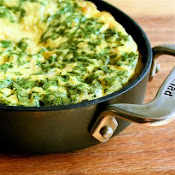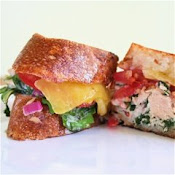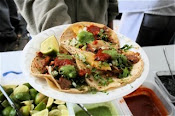Grand Marnier Chocolate Truffles
Yield 35
10 oz bittersweet chocolate, chopped
3 tablespoons unsalted butter
½ cup heavy cream
1 tablespoon light corn syrup
¼ teaspoon kosher salt
¼ cup Grand Marnier
12 oz candy-making chocolate disks (dark), Merckens brand works well (*see note in directions below)
½ cup Dutch process cocoa powder
Place the bittersweet chocolate and the butter in a microwave-safe bowl and heat for 30-60 seconds, stirring after the first 30 seconds. Alternatively, melt chocolate and butter together in a bowl set over (not touching) gently simmering water.
In a small sauté pan or saucepan, heat cream, corn syrup and salt until simmering. Pour over melted chocolate mixture and let stand 1-2 minutes. With a spatula gently stir mixture until evenly blended. Pour the alcohol, about a tablespoon at a time, into the chocolate mixture, stirring well after each addition. Pour mixture into an 8x8 inch baking dish, preferably glass or Pyrex. (Glass or Pyrex is best because eventually you'll be scraping the bottom of the pan with your truffle scoop, and these two materials won't be harmed.) Let chill in the refrigerator for at least one hour or overnight.
Line a cookie sheet with parchment paper. Using a truffle scoop (also called a #100 scoop) or a melon baller, gently drag the balled end across the surface of the chocolate. Release the ball of chocolate onto the cookie sheet and repeat until all of the chocolate has been scooped. These balls should not look perfect—don't worry if they look irregularly-shaped, and don't try to reshape them into perfect balls—in fact, they should appear slightly misshapen. Let chill in the refrigerator for at least another hour.
This next step is the only tricky part. Chocolate seizes very easily. This means that if a drop of water happens to get into the chocolate mixture, the chocolate will form into a grainy mass precluding it from being able to coat the balls. So regulating the temperature of the chocolate is important: it needs to be warm enough to easily coat the balls, but it also cannot be overheated.
*Note: 12 oz of chopped semisweet or bittersweet chocolate can be used in place of the candy-making chocolate disks, but I find the candy-making chocolate disks to be more forgiving in regard to seizing and they also give a crisper coating than regular semisweet or bittersweet chocolate.
Follow these steps carefully:
Place the coating chocolate in a large stainless-steel bowl (larger than you think necessary for the amount of chocolate.) Fill a pot large enough to accomodate the bowl with a few inches of water. Bring to a boil, then reduce to a very gentle simmer and place the bowl with chocolate over the pot being sure that the bottom of the bowl is not touching the water. After a a few minutes stir the chocolate with a heat-proof spatula, not a wooden spoon (supposedly wooden spoons can carry moisture). Place the cocoa powder in a shallow vessel—a small rectangular-shaped Tupperware works well. Have a clean Tupperware ready for the finished truffles.
When the chocolate is smooth and melted, remove the bowl from the heat. Remove the chocolate balls from the refrigerator. Place a large stainless-steel spoon (not a dinner spoon but a large cooking spoon) in the bowl and using the spatula push chocolate into the spoon to fill. Working one at a time, place one ball into the chocolate-filled spoon. Quickly coat the ball using the spatula, then remove using a small stainless-steel "dinner" spoon, and transfer to the cocoa powder. Gently shake the vessel back and forth until the truffle is coated, and let sit while you move to the next one. Repeat with two more before removing the first finished truffle. After 3 or 4 of the truffles have been coated, remove the first completed truffle to the clean vessel. Eventually you will work out your own system, but the truffles do need to rest for about 15 seconds before they are transferred to the clean vessel—the chocolate coating needs to set briefly. Towards the end of this coating process, you may need to place the bowl back over the water to gently warm the chocolate again so it more easily coats the chocolates. Just follow the same procedure as above—the key is to melt the chocolate slowly and to keep moisture out of the inside of the bowl. Keep the un-dipped chocolates cool in the refrigerator while you reheat the chocolate.
Once all of the truffles are coated, store in the refrigerator until ready to serve. If you prefer to eat them at room temperature, remove them from the refrigerator one hour prior to serving.
Note: After the chocolates have chilled in the refrigerator for a few hours and are firm, taste one. If the cocoa-powder coating is too strong, try this: set a cooling rack over a sheet tray and working with a few truffles at a time, shake them back and forth with your hands to remove excess cocoa powder. Return to the refrigerator in a clean Tupperware.
Note: You may have left over cocoa powder and coating chocolate. You can store the remaining coating chocolate in the refrigerator and use for another project or use in a recipe for chocolate sauce or hot cocoa. The remaining cocoa powder can also be saved for hot cocoa.
















